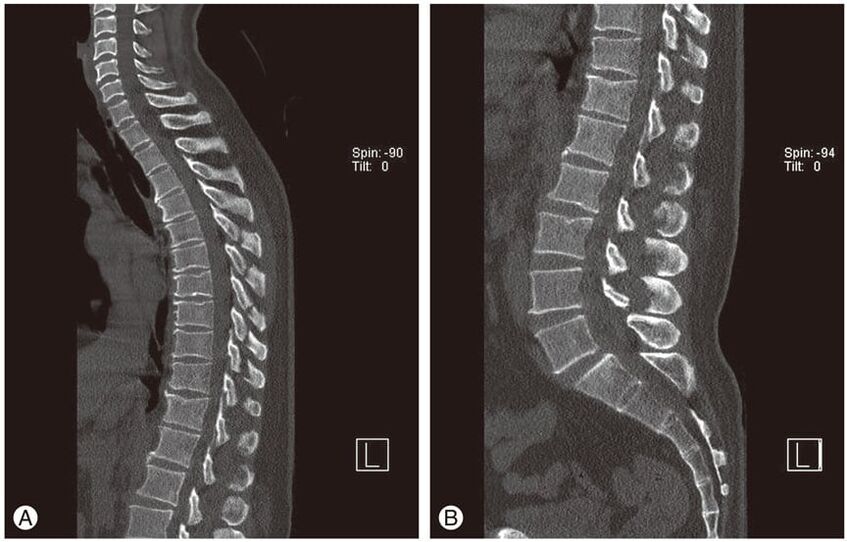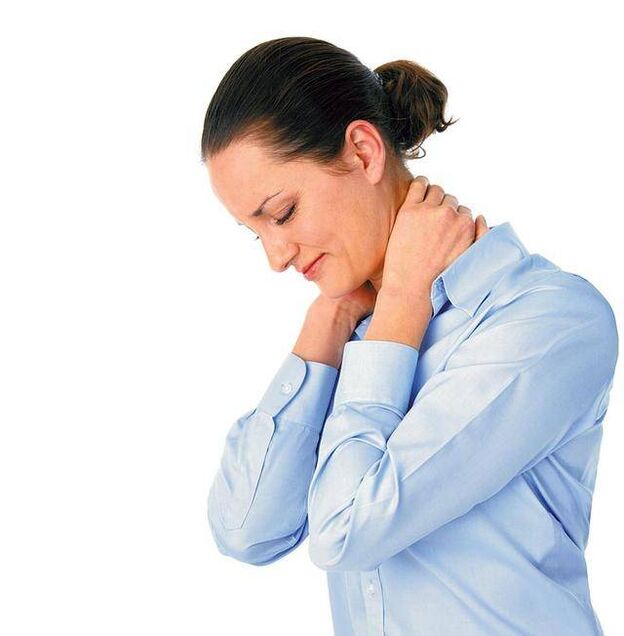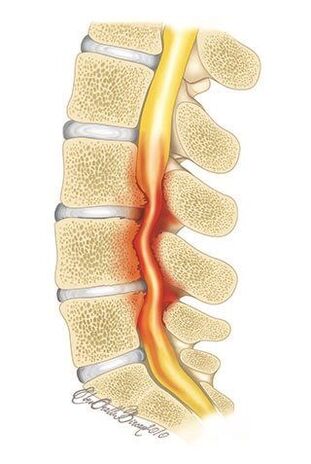Osteochondrosis of the thoracic spine is a severe degenerative-dystrophic pathology that is not yet susceptible to a definitive cure. It proceeds against the background of the destruction of the intervertebral discs, displacement and protrusion of the vertebrae. When diagnosing the disease, doctors take into account that the signs of thoracic osteochondrosis in women and men are different. This is due to hormonal fluctuations in the female body. Women often adhere to diets, wear narrow high-heeled shoes, and have difficulty experiencing domestic conflict. This affects the development, course and progression of the pathology of the musculoskeletal system.

Differences between female and male clinical manifestations
Diagnosis of thoracic osteochondrosis in women causes more difficulties due to the peculiarities of the hormonal background. In young patients, it is subject to frequent monthly fluctuations. In women during natural menopause, the production of hormones in the body decreases. This can cause the development of pathologies, they must be differentiated. Men are characterized by a typical course of the disease, which makes it possible to detect it in a timely manner and immediately start treatment.
The clinical picture of thoracic osteochondrosis in women includes numerous signs that are so specific that it is sometimes difficult to classify them as symptoms of pathologies of the musculoskeletal system. Doctors distinguish such characteristic differences between the male and female clinical picture, the further progression of thoracic osteochondrosis:
- clinical manifestations in women occur a little earlier. This is due to the spinal column, which is more fragile and vulnerable to the action of negative factors, increased sensitivity to painful sensations;
- the intensity of pain in the thoracic region, stiffness varies depending on the menstrual cycle. This is due to the body's production of estrogen - steroid sex hormones. They reduce the severity of pain that occurs against the background of thinning of the intervertebral discs and spasm of the neck muscles. Therefore, during the initial diagnosis, based on patient complaints, women are not always able to informatively describe the sensations that disturb them;
- in men, thoracic osteochondrosis rarely provokes the development of a concomitant disease. And in women several pathologies can occur at the same time. At the same time, osteochondrosis can provoke the development of a disease that is not associated with the musculoskeletal system. On the contrary, an endocrine or metabolic disorder leads to the destruction of cartilage tissue;
- for the treatment of thoracic osteochondrosis, women are prescribed drugs that are used in the treatment of men in rare cases. These are antipsychotics, tranquilizers, sedatives. The psychoemotional state of women is more labile, so among the symptoms are anxiety, increased anxiety and insomnia. Sometimes, with the news of the incurability of the disease, depression appears, which is eliminated only by a course of antidepressants.

Women are more likely to experience headaches. But unlike men, they do not suffer an increase in the intensity of clinical manifestations during the day due to the action of estrogens.
An interesting fact is that with the progression of pathology in women, libido can increase. This is how steroid hormones work, which are intensively produced in the body to suppress pain. And the sexual desire of men is significantly reduced as a result of a disorder of the innervation of the prostate.
Typical signs of the disease.
Patients often complain to doctors of pain in the shoulder blade area, which is aggravated by bending or twisting the body. It radiates to the sides, the lower back, and even the forearms. Pain is felt along the intercostal nerve, its intensity increases when coughing, laughing, sneezing. Reflected pain complicates the diagnosis, requires additional studies, consultations with an endocrinologist, cardiologist, mammologist, gynecologist.
The characteristic signs are stiffness, a feeling of stiffness.When moving, changing the position of the body, specific clicks are heard, usually associated with the displacement of the vertebrae relative to each other. Typical symptoms of thoracic osteochondrosis in women also include the following clinical manifestations:
- feeling of "progressive goosebumps", decreased sensation to touch in the chest or abdomen, numbness of some areas of the skin;
- appearance of signs of intercostal neuralgia. When lifting weights, increasing physical activity, hypothermia, there is a sharp, piercing pain in the region of the ribs, spreading to the chest and sides;
- the development of stable dorsalgia - a combination of pain sensations of varying degrees of intensity in the back. They can occur even when inhaling, intensify when climbing stairs, doing any housework;
- muscle spasm that limits range of motion. Muscle spasm occurs in response to compression by an osteophyte (bone growth) or inflammatory edema of sensitive nerve endings in soft tissues.
Thoracic osteochondrosis is characterized by constant tension of the muscles located near the spine. This is detected by palpation during the initial examination, as well as pain in the area of the nerve endings. There is a change in posture, the march of a woman. She tries to keep her back straight to avoid pain. But with pathology of the third degree, a curvature of the spine is already observed against the background of the development of scoliosis and a decrease in the distance between the vertebrae.
Specific symptoms of the pathology.
Thoracic osteochondrosis is rarely diagnosed. This section of the spine is equipped with a powerful muscular corset, and its strong attachment to the ribs allows it to withstand intense static and dynamic loads. Doctors often call thoracic osteochondrosis a "chameleon disease. "To detect it, differential diagnosis is required not only for pathologies of the musculoskeletal system (arthritis, spondyloarthrosis), but also for diseases of internal organs.
Patients often come with complaints not to a vertebrologist or neuropathologist, but to a cardiologist, nephrologist, gastroenterologist, gynecologist. The fact is that the symptoms of thoracic osteochondrosis are disguised as clinical manifestations of angina pectoris, cholecystitis and renal colic. And an attack of intercostal neuralgia is very similar to a heart attack or appendicitis. What atypical signs of osteochondrosis of the thoracic spine in women can occur at the stage of remission or relapse:
- pain in the heart region. They are confused with an angina attack or a myocardial infarction. Cardiologists exclude cardiac pathologies after studying the results of an ECG and other instrumental tests;
- pain in the mammary glands. Discomfort does not go away for a long time, and its intensity does not decrease. After the patient contacts a gynecologist or mammologist, an ultrasound scan of the mammary glands is performed to exclude benign and malignant neoplasms;
- pain in the gastrointestinal tract (GIT). A woman goes to a gastroenterologist after the appearance of constant pain in the right hypochondrium or epigastrium or periodic. When diagnosing gastritis, cholecystitis, ulcerative lesions, various laboratory and instrumental studies are carried out;
- Pain in the lower abdomen. They often occur due to compression of the nerve endings in the spinal cord. Painful sensations and urination disorders are similar to signs of diseases of the genitourinary system. Urologists or gynecologists differentiate osteochondrosis from pyelonephritis, glomerulonephritis, and uterine fibroids.
Despite the increased libido caused by estrogen production, patients show dysfunction of the reproductive system. Anorgasmia (lack of orgasm) develops against the background of compression of the nerves innervating the lower part of the thoracic region of the back.

The close localization of pathologies to the internal organs and the innervation community causes very specific clinical manifestations. They are sometimes disguised as strokes, kidney failure, liver colic, and even dental disease. The medical literature describes cases of tooth extraction treated due to intense and persistent pain at its base. Subsequently, the cause of the pain syndrome was established - neurological symptoms of thoracic osteochondrosis.
Vertebrological signs are more characteristic of cervical pathology, but are sometimes also detected in severe thoracic pathology. Destructive-degenerative processes in the vertebrae and discs provoke sharp jumps in blood pressure, dizziness, impaired coordination of movements, headaches and tinnitus. There have been cases of decreased visual acuity.
Psychoemotional disorders (crying, anxiety, mood swings) are diagnosed in many patients. Health problems, the news of an upcoming surgical operation, decreased physical activity sometimes become the causes of a depressive state.
How to eliminate the symptoms of thoracic osteochondrosis.
The methods of treatment of degenerative-dystrophic pathology in women and men are the same. Destroyed cartilage tissue cannot be restored, so the main goals of therapy are to reduce the severity of symptoms and prevent further spread of the pathology.
When choosing a method, the doctor takes into account the degree of destructive changes, the presence of an inflammatory process in the soft tissues, the stage of the course of thoracic osteochondrosis. Women are much more likely than men to be prescribed antidepressants, tranquilizers and sedatives. During the period of natural menopause, hormone replacement therapy may be prescribed, which is also necessary for the prevention of osteoporosis (decreased bone mass).
To eliminate pain in thoracic osteochondrosis in women, drugs of various clinical and pharmacological groups are used:
- nonsteroidal anti-inflammatory drugs (NSAIDs)in tabletsAfter a week of taking and improving well-being, women are prescribed external forms of NSAIDs;
- hormonal preparations. Glucocorticosteroids are generally used for drug blockades;
- muscle relaxants. Relaxes skeletal muscles, relieves painful muscle spasms;
- chondroprotectors. They partially regenerate damaged hyaline cartilage, after a couple of weeks of administration of the course, they have an analgesic effect.
In the treatment of thoracic osteochondrosis, physiotherapeutic procedures are actively used: UHF therapy, laser therapy, magnetotherapy, applications with ozokerite, paraffin, bischofite. Patients are shown massage, physiotherapy exercises, swimming, yoga.
If a woman does not seek medical help, diseases of the internal organs may soon develop. They are provoked by the protrusion of the intervertebral disc into the narrowed spinal canal and the formation of hernias. The deterioration of the spinal column leads to compression of the spinal cord, and then to the appearance of renal, hepatic, gastrointestinal or cardiovascular pathologies.
















